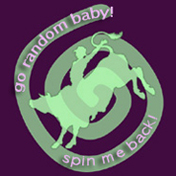
Y’know, as much as I’m critical of the woo-mongers mixing it up with what they perceive to be ‘science’, I’m afraid that sometimes it’s the scientists themselves that need a good fresh mackerel to the side of the head.
Take this article Chaos Makes a Scream Sound Real, from ScienceNews.
To be fair, it’s not just the scientists. There’s a combination of factors that contribute to the diffuse, nutty quality of this piece, and it’s one that you find frequently in science journalism: a scientific concept that doesn’t immediately appear to be anything remotely worth reporting to a general audience, and a journalist’s desire (or job requirement) to try and spice it up into something that does.
I’ll try and paraphrase the whole idea for you, since I can’t be entirely sure what this is exactly about from reading either the Science News article or the abstract of the paper at Biology Letters, where it was published under the title Do film soundtracks contain nonlinear analogues to influence emotion? ((And I’m not about to fork out for the full article – people still aren’t getting this stuff. Listen to me Biology Letters editors: religious fundamentalists of all persuasions make their stuff available to all and sundry for nothing. THEY ARE YOUR COMPETITION! Get with the 21st Century already!))
Some scientists studying vertebrate communication observed that:
A variety of vertebrates produce nonlinear vocalizations when they are under duress. By their very nature, vocalizations containing nonlinearities may sound harsh and are somewhat unpredictable; observations that are consistent with them being particularly evocative to those hearing them.
What they’re basically saying is that jarring, loud or sudden sounds have a noticeable impression on an animal hearing them.
Yup.
They go on to hypothesize that maybe this is the case for humans too, and that filmmakers use that trick in films.
Yup.
To this end, they analyzed a bunch of films and found that there are more jarring and sudden sounds in horror films, although some appear in action films and a few appear in drama. ((Without even doing an experiment I can tell you that there would be close to none in comedies and romances.))
Yup.
Then they sum up their hypothesis with:
Together, our results suggest that film-makers manipulate sounds to create nonlinear analogues in order to manipulate our emotional responses.
(Translate that to: ‘Film-makers use different kinds of changing sounds for emotional effect’)
Er… Yup.
Now, I don’t suppose that this was likely to be an experiment that cost oodles of money, but whatever they spent on it was WAY too much, because they could simply have emailed me and I would have told them all that for free.
The Science News reporter makes a futile attempt to spin this up into something more than what I just told you, by stirring in some references to Chaos Theory (wtf?) and getting a quote about ‘crying babies’ from a cognitive biologist who was not even involved in the study (‘Screams are basically chaos!‘). She then tags the piece with an entirely irrelevant factoid about how Hitchcock’s The Birds contains sounds that were electronically generated ((I’m not even sure I understand what the point of including it is – that electronic sounds are more jarring/chaotic/annoying than natural sounds? Again, wtf? It’s not true, and it’s immaterial in this context anyway!)) and signs off with the following knowledgeable-sounding quip:
…capturing a realistic, blood-curdling cry is so difficult that filmmakers have used the very same one, now found on many websites, in more than 200 movies. Known as the Wilhelm scream it is named for the character who first unleashed it in the 1953 western The Charge at Feather River.
Well, someone has been pwned here and I’m not sure who. Either the reporter hasn’t done her homework, or she thinks that no-one will notice this risible flub. The Wilhelm scream is used in a lot of movies, not because of its terrifying blood-curdling quality, but because it’s so utterly lame that it has become a game among sound editors to see if they can sneak it in skillfully enough to let the director keep it in the final sound mix.
What’s more, it’s even extremely well known for that reason as even a very cursory search will reveal. Here’s a (VERY old) YouTube compilation of appearances of the Wilhelm scream.
You’ll have noticed that many of the above clips are from the George Lucas/Steven Spielberg stable, and that’s because sound design guru Ben Burtt is responsible for ‘resurrecting’ the Wilhelm scream in Star Wars and the fun challenge of trying to get it into mixes arose among sound editors who worked with Burtt (and with some of whom I’ve worked myself, so I know of what I speak).
I’m all for the concept of popularizing science, but this kind of writing doesn’t really help anyone. It’s painting a hazy and inaccurate picture for a lay audience, can easily be demonstrated to be factually sloppy and, worst of all in my book, because of the two preceding transgressions, casts a sickly glow over the effectiveness of all other science reporting. Science can’t, and shouldn’t be, reported in the same way as entertainment. Science is interesting for what it is, and if you’re a science reporter and can’t find an appropriately absorbing way of working with the actual facts at hand for a story, you should leave it alone and go on to something else. ((Another disappointing consequence of this phenomenon is that the bad story gets picked up, often completely uncritically, by other popular science outlets. In this case I note that it appears in Wired Science who should totally know better.))



